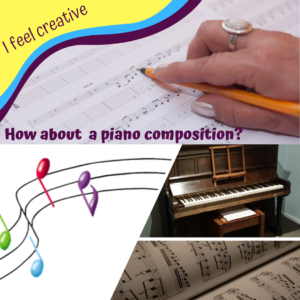Are You Inspired to
Create a Piano Composition?
I was inspired to create a piano composition simply from the weather and driving on a June sunny winters day. I wanted a simple short tune which people could play in their first year or two of playing the piano.
The day started with a heavy frost which took some time to remove from my car. Hence the piano composition I created is titled Frosty Morning. You can view the Frosty Morning Piano Composition here.
So how did I come up with the tune?
Firstly you need some knowledge of bars, key signatures, time signatures, intervals, scales and chords.
What I did was to sing whilst I was driving with various melody options and appropriate words around the frosty morning I was experiencing. I wanted to mention the -2 degrees temperature, the heavy ice crystals on my car, the cool sunny day and the snowy mountains in the background whilst driving…all my experiences from the frosty morning.
When I arrived at my next destination I quickly scribbled the words and melody down on a piece of paper before I forgot it. Later in the day when I was home I opened up Musescore, a free music writing software program, and typed in the melody that I had come up with.
Key Signatures
I knew I wanted it in C major which is the key many beginner pieces are in; that is no flats or sharps. The first, third and fifth bars consisted of the C major arpeggio or parts thereof. Most pieces end on the key note so I ended the piece on C. I had to change some words to fit the rhythms I wanted and other rhythms to fit the words I wanted.
Scales and Chords
Then it was time to add the left hand notes and chord symbols. This is where you need a knowledge of the C major scale and the chords based on each degree of the C major scale.
A C major scale consists of the notes ****C D E F G A B ****
Each of the notes of the scale represents a different degree of the scale and are given names as follows, with the C major scale as an example.
Tonic ————————- 1st Degree——————— C
Supertonic——————2nd Degree——————–D
Mediant——————— 3rd Degree——————–E
Subdominant————-4th Degree——————–F
Dominant——————-5th Degree——————–G
Submediant—————-6th Degree——————–A
Leading Tone————–7th Degree———————B
On each of the notes in this scale you can build chords, taking note of the key signature of no flats and sharps. A chord is 3 or more notes.
The chords of each degree of the C major scale areas follows.
C: C E G major
D: D F A minor
E: E G B minor
F: F A C major
G: G B D major
A: A C E minor
B: B D F diminished
Choosing the chord symbol
I went to the piano and played around with some notes. I knew the 1st, 3rd, 5th and last bars were in C major. Therefore I could put the C chord symbol above those bars. In the second bar, the 1st notes of beat 1 and 2 were A and F. Therefore I looked at the chords of each degree given above and choose a chord which consisted of those 2 notes. I see that I could have picked D minor or F major. In this case I picked F major. The 3rd and 4th beats had the notes G and E. Therefore I could pick C major or E minor. I picked C and put this symbol above the 3rd beat.
So basically you just look at the melody notes which lie on the main beats of the bar and if there are 2 different notes look for a chord which has both of them. Bar 4 and the 2nd half of bar 7 had the options of D minor and B diminished and I picked D minor, beat 4 in bar 6 and beats 1 and 2 in bar 7 had the options of C major and E minor and I choose C major. The best option for the 1st 3 beats of bar 6 is a G or G7 chord. When there is a 7 after a chord symbol it just means the 7th note of the scale is added making it a 4 note chord. So a G7 chord would consist of the notes G B D F. Both options would work.
Adding the left hand notes
Finally you add notes which fit around the chord or scale of that chord which sounds good with the melody line. So I played notes on the piano until I was happy with notes that sounded good together. If I had chosen the other chord options the feeling of the piece would be different.
Final Note
Are you interested in making up your own tunes?
If so, create a melody which you like that sounds good and ends on the key note or first degree of the scale which you choose.
Maybe you have an inspiration from the day, like a frosty morning.
Consequently if you are creating a piano piece then look at the notes on the main beats of the bar and choose chords which have the notes in. Try all options out and see which ones you like the best. Choose a time signature you are happy with.
Why not download some
and give piano composition a go.
